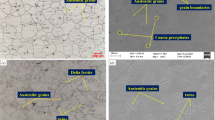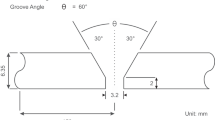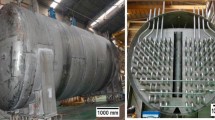Abstract
Aluminum alloys are used as construction material for ultra-high vacuum (UHV) chambers of synchrotron radiation sources (SRS) due to UHV compatibility, high thermal conductivity and non-magnetic requirements. Aluminum alloy AA5083-H321 has been used as material of construction for UHV dipole chambers of Indus-2 SRS at RRCAT. Weld joints of UHV chambers require helium leak tightness less than 2E-10 mbar·l/s. Weld joint design and selection of right base and filler materials need special care in obtaining leak tight joints of vacuum chambers by gas tungsten arc welding (GTAW). GTAW is used in the fabrication of the present dipole chambers which are welded in lip-fillet configuration. One of the in-service dipole chambers has developed leak over time at few locations and has been repaired in-situ. This failure due to fine cracks developed in the weld region of the dipole chamber can be attributed to either material of construction or weld design. In this study, GTAW welding of similar base alloys viz. AA5083 to AA5083 with filler rod ER5183 and AA6061 to AA6061 with filler rod of ER4047 has been carried out. It reports the investigations carried out with respect to their GTA welds fabricated in two different weld joint designs. Computational studies were also carried out to obtain residual stresses in weld joints using finite element analysis (FEA). The GTA weld joints are subjected to various quality tests including helium leak test, thermal cycling and metallographic examination. Helium leak tightness (2E-10 mbar·l/s) was achieved in both the welds of AA5083 (ER5183 filler) and AA6061 (ER4047 filler), however, fine cracks are seen at the root of AA5083 welds whereas welds of AA6061 were free of such defects. Based on these investigations, weld-joint design and material of construction (including filler material) are proposed for new dipole vacuum chambers of Indus-2.


























Similar content being viewed by others
References
D.D. Bhawalkar, G. Singh and R.V. Nandedkar, Synchrotron Radiation Sources Indus-1 and Indus-2, PRAMANA-J. Phys. Indian Acad. Sci., 1998, 50(6), p 467–484.
V.K. Bhatnagar, A.K. Jain, Fabrication of Dipole Vacuum Chamber, Proceedings of APAC, Gyeongju Korea (2004), 770-771.
S. K. Singh, R. M. Tiwari, A. Kumar, S. Kumar et al., Mechanical Properties And Microstructure of Al-5083 by TIG, Materials Today: Proceedings, Volume 5, Issue 1, Part 1 (2018), https://doi.org/10.1016/j.matpr.2017.11.152, 819-822.
M. Srivastava, G. Vanga and G.N. Kumar, Experimental Study of Mechanical Properties of 5083 Aluminium Alloy Using Gas Tungsten Arc Welding, Int. J. Innov. Res. Sci. Eng. Technol., 2016, 5(5), p 7324–7331.
M. Arun and K. Ramachandran, Effect of Welding Process on Mechanical and Metallurgical Properties of AA6061 Aluminium Alloy Lap Joint, Int. J. Mech. Eng. Res., 2015, 5(1), p 163–178.
S. Jannet, P.K. Mathews and R. Raja, Comparative Investigation of Friction Stir Welding and Fusion Welding of 6061T–6 & 5083–0 Aluminium Alloy Based on Mechanical Properties and Microstructure, J. Achiev. Mater. Manuf. Eng., 2013, 61(2), p 181–186.
P. Kah, E. Hiltunen, J. Martikainen, Investigation of Hot Cracking in Welding of Aluminium Alloys (6005 and 6082), 63rd annual assembly and international conference of the international institute of welding, Istanbul, Turkey (2010), 373-380
J. Ahn, L. Chen, E. He, C.M. Davies and J.P. Dear, Effect of Filler Metal Feed Rate and Composition of Microstructure and Mechanical Properties of Fibre Laser Welded AA2024-T3, J. Manuf. Process., 2016 https://doi.org/10.1016/j.jmapro.2016.10.006
H. Zhao and T. Debroy, Weld Metal Composition Change During Conduction Mode Laser Welding of Aluminium Alloy 5182, Metall. Mater. Trans. B., 2001, 32B, p 163–172.
Simufact Welding, Structural Welding Simulation, MSC Software Company.
G. Cao, S. Kou, Predicting and Reducing Liquation-Cracking Susceptibility Based on Temperature vs Fraction Solid. Weld. J. Res. Suppl. (2006), 9-18
G. Cao, S Kou, Liquation Cracking in Full Penetration Al-Si Welds. Weld. J. Res. Suppl. (2005), 63-72
L. Suominem, M. Khurshid and J. Parantainen, Residual Stresses in Welded Components following Post-Weld Treatment Methods, 5th Fatigure Design Conference, Fatigue Design, Proc. Eng., 2013, 66, p 181–191.
A. Hobbacher et al., Recommendations for fatigue design of welded joints and components (update). IIW doc. XIII-1965-03/XV-1127-03; revision 2006
D. Andud, M. Azhar, W. Zainul, Y. Manurung, S. Bani, K. Salim, M. Said, M. Ackeil, S. Saidin, K. Kasim and D. Ishak, Simulation Study of Welding Distortion on Multi pass Welding of the Fillet Joint, J. Sci. Technol., 2016, 3(01), p 1–5.
G.A. Taylor, M. Hughes, N. Strusevich, K. Pericleous, Finite Volume Methods Applied to the Computational Modelling of Welding Phenomena, 2nd International Conference on CFD in Minerals and Process Industries (1999), 1-6.
N. Akkus, E. Toptas, O. Topal, Thermomechanical analysis of Arc Welded Joint by Finite Element Method, International Congress on Advances in Welding Science and Technology for Construction, Energy and Transportation System, AWST-11/119 (2011)
B.Q. Chen, M. Adak, C.G. Soares, Thermo-Mechanical Analysis of Effects of Weld Parameters in Ship Plates During Welding Process, Proceedings of the 2nd International Conference on Ship & Offshore Technology (2011), 23-30
S. Hwang, J.H. Lee, S. Kim and K.K. Viswanathan, Numerical Simulation of Welding Residual Stress Distribution on T-joint Fillet Structure, Int. J. Ocean Syst. Eng., 2012 https://doi.org/10.5574/IJOSE.2011.2.2.082
B.Q. Chen, M. Adak, C.G. Soares, Numerical Investigations to Study the Effect of Weld Parameters on Temperature-Time History in Steel Plates, Centre for Marine Technology and Engineering (2012), 285-291.
J. Goldak, A. Chakravarti and M. Bibby, A New Finite Element Model for Welding Heat Sources, Metallurgical, Transactions, 1984, 15B, p 299–305.
J. Goldak and M. Akhlaghi, Computational Welding Mechanics, Springer, New York, 2005, p 1–20
M.C. Seyyedia, M. Haghpanahi and M. Sedighi, Investigation of the Effect of Clamping on Residual Stresses and Distortions in Butt-Welded Plates, Scientia Iranica Trans. B Mech. Eng., 2010, 17(5), p 387–394.
Y. Fang, S. Dong, H. Jia, X. Dong, H. Cheng, Influence of Mesh Size on Welding Deformation and Residual Stress of Lap Joints, 1st International Conference on Advanced Algorithms and Control Engineering. https://doi.org/10.1088/1742-6596/1087/4/042085 (2018), 1-6
JMatPro 4.0 User’s Guide, Sente Software Ltd. (2005)
M. Vishwanath, N. Lakshamanaswamy and G. Ramesh, Numerical Simulation of Heat Trasnfer Behaviour of Dissimilar AA5052-AA6061 Plates in Friction Stir Welding: An Experimental Validation, J. Mech. Eng., 2019, 69(1), p 131–142.
N. Hempel, J.R. Bunn, T.N. Pagel, E.A. Payzant and K. Dilger, Study on the Residual Stress Relaxation in Girth-Welded Steel Pipes Under Bending Load Using Diffraction Methods, Mater. Sci. Eng., 2017, 688, p 289–300. https://doi.org/10.1016/j.msea.2017.02.005
H. Arora, R. Singh and G.S. Brar, Numerical Simulation on Residual Stresses of Stainless-Steel SS-304 Thin Welded Pipe, Measur. Control, 2020, 53(7–8), p 1183–1193. https://doi.org/10.1177/0020294020917173
N. Hempel, T.N. Pagel and K. Dilger, Residual Stresses in Multi-Pass Butt-Welded Tubular Joint, Adv. Mater. Res., 2014, 996, p 488–493.
Acknowledgments
We would like to express our sincere thanks to Director, Proton Accelerator Group, RRCAT, Mr. P. Shrivastava, for his valuable technical discussions and constant encouragement towards this work. Colleagues of Ultra High Vacuum Technology Section, RRCAT deserve our gratefulness for their direct or indirect supports for the experimental and characterization works. Support of Shri Vinod Vishwakarma for preparation of sketches for the manuscript is duly appreciated.
Author information
Authors and Affiliations
Corresponding author
Additional information
Publisher's Note
Springer Nature remains neutral with regard to jurisdictional claims in published maps and institutional affiliations.
Rights and permissions
About this article
Cite this article
Sharma, S.K., Gupta, H., Jain, V.K. et al. Investigation of Ultra-High Vacuum Compatible Weld Joints of AA5083 and AA6061 Materials for Synchrotron Radiation Source. J. of Materi Eng and Perform 31, 4795–4810 (2022). https://doi.org/10.1007/s11665-022-06589-8
Received:
Revised:
Accepted:
Published:
Issue Date:
DOI: https://doi.org/10.1007/s11665-022-06589-8




